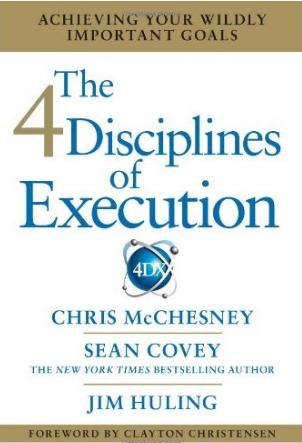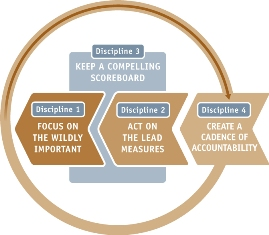02 Apr 2013 07:06 pm
Posted by Dave under Book Review,Dave's Thoughts
4DX
 The 4 Disciplines of Execution: Achieving Your Wildly Important Goals
The 4 Disciplines of Execution: Achieving Your Wildly Important Goals
by Chris McChesney, Sean Covey, Jim Huling; 2012; Free Press (ISBN: 978-1-4516-2705-3)
The 4 Disciplines of Execution, or “4DX” as the authors abbreviate the title, comes across as a pure business-oriented “pull your self up by the bootstraps and prosper” self-help book. The entire dust jacket, as well as the first 10 pages and the forward are filled with self-congratulatory bumpf that is stereotypical of the genre. Not a particularly compelling start…
So, what was I doing reading about the “next big thing” from the FranklinCovey Group? The 4DX concept, and the book, had been specifically mentioned by the director of the group that I am working for at TransCanada during a quarterly departmental update meeting. The 4DX principles were being used to set strategic and tactical direction for the group. Well, clearly, if my boss’s boss is interested in something, then so am I!
Once I got into the meat of the book, I found that my initial skeptical concerns were being addressed by a thoughtfully developed set of business practices that the author calls the four disciplines; these are:
- Discipline 1: Focus on the wildly important
- Discipline 2: Act on Leading Measures
- Discipline 3: Keep a Compelling Scoreboard
- Discipline 4: Create a Cadence of Accountability
The essence of the 4DX methodology is to select one extremely important goal out of numerous potential initiatives and objectives, which may be important in their own right but are not the most important. This focus is critical as it compels you to rise above the whirlwind of day-to-day business and be clear about what really matters. The focus is then quantified by stating it as a “get from A to B by this deadline”.
So far, not much new. The second and third disciplines are where the game changes into something a little different. The discipline 1 goal is stated as a measurable idea, “from A to B by date”, just like any other business book might advise. This is a measure that can only be reviewed – it lags the actual activities that cause the movement from A to B. By the time you get the report or scorecard it is too late to influence what you did last week or last month. Discipline 2 changes the emphasis towards actions that act as leverage on the goal by looking for another kind of measure – a leading measure. Leading measures are predictive and influence-able indicators of behaviours that support the goal. Discipline 3 then makes both the goal and the leading measures relevant by presenting the progress as a real-time scoreboard that shows clearly whether the team is winning or losing the game of reaching the goal.
It’s like a pick-up game of street hockey – the entire experience changes when scorekeeping starts and changes most significantly when the players themselves are the scorekeepers. The first three disciplines set up the game (focus on winning), provide leading indicators for behaviours related to achieving the win (how many shots on goal each shift?) and provide feedback on progress towards winning (what’s the score right now?).
 All well and good, but if these ideas set up the game, it’s the last one that puts the team in the game. Discipline 4 creates accountability for the independent actions of team members to move the game along. It is the communication that allows individuals to commit to action and follow-up. It is a cadence of checking in and checking up that moves the leading measures and gets results – despite the whirlwind.
All well and good, but if these ideas set up the game, it’s the last one that puts the team in the game. Discipline 4 creates accountability for the independent actions of team members to move the game along. It is the communication that allows individuals to commit to action and follow-up. It is a cadence of checking in and checking up that moves the leading measures and gets results – despite the whirlwind.
The inevitable question is then, “How do I actually do that?” The theory sounds good, but putting it into practice? This is where the authors have made an admirable attempt to get real. Using an interesting combination of text and web content accessed by QR codes in side notes, the authors have attempted to make the book a multi-media experience with short video clips of interviews with people who have put the 4DX ideas into practice. It works, sort of. The process of browsing to the website and watching a video clip takes a bit of time and disrupts the flow of the book. (Disclaimer: I actively despise the distracting habit many authors/publishers have of littering a book with large font excerpts from the text randomly interspersed in the prose.) Worse though, the second QR code I scanned didn’t take me to the extra content directly; instead it went to a sign-in page that wanted my name and email address before I could get to the content. Needless to say FranklinCovey simply gathered bogus information for their spam-victim database.
Bottom line on this book? I felt it was a good, concise take on a measurement based accountability system that should get results. Focusing on one important objective and reaching for it through smart use of leading measures and agile-style accountability makes sense and should be scalable to any sized team or organization. The how-to information is down-to-earth and accessible as well. This technique appears to be useable not only in business but in any other area of life where the chaos of the whirlwind might otherwise blow away the best of intentions to win the game.
Leave a Reply
You must be logged in to post a comment.